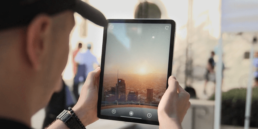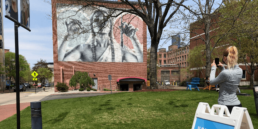New universal links and camera-based augmented reality browser allows anyone to extend traditional webpages, social post, texts, or emails with content that users can experience in their physical space.
Hoverlay Inc. is excited to announce the launch of Hoverlay 2.0, its latest iOS and Android camera-based AR browser and mixed reality SaaS platform that drastically simplifies the creation and sharing of interactive “digital twins” or replicas of physical products, artwork, and people. Hoverlay generates a unique URL for each digital twin, which can be placed in web pages, social posts, texts, or emails. Once clicked, users receive, experience, and interact with the digital twin within their personal environment. Built upon ARKit and ARCore, Hoverlay provides today’s most powerful spatial computing capabilities, while ensuring a seamless integration into today’s user journeys.
Using Hoverlay, artists and online galleries can turn jpg or png artwork images into size-accurate digital twins that can be virtually hung on any wall. By turning a green-screen video straight into a hologram, marketers can bring digital replicas directly to users’ physical space to better educate, convince, assist, or entertain their customers. Engineering teams can send physically accurate versions of their product concepts to sellers, partners, and early adopters for quick feedback. Hoverlay’s technology allows existing 2D, video, or 3D content to be turned into interactive digital twins
Unlike the previous generation of AR solutions, Hoverlay does not need markers to place artworks or products on walls or floors as its camera browser automatically detects user environment and displays content accordingly. In addition, Hoverlay’s APIs enable easy integration into any e-commerce platform or product catalog at scale. Nicolas Robbe, Hoverlay’s CEO and co-founder states: “The boundaries between digital and physical space are becoming more fluid. Our new platform offers the first end to end solution for anyone looking at integrating their content seamlessly into our physical environments and taking advantage of the Spatial Web to be more productive and creative.”



